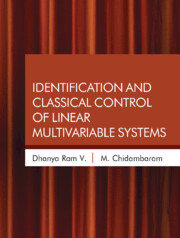Book contents
- Frontmatter
- Contents
- Preface
- Acknowledgements
- List of Abbreviations
- Notations
- 1 Models, Control Theory, and Examples
- 2 Identification and Control of SISO Systems
- 3 Introduction to Linear Multivariable Systems
- 4 CRC Method for Identifying TITO Systems
- 5 CRC Method for Identifying SISO Systems by CSOPTD Models
- 6 CRC Method for Identifying TITO Systems by CSOPTD Models
- 7 Identification of StableMIMO System by Optimization Method
- 8 Identification of Centralized ControlledMultivariable Systems
- 9 Identification of Multivariable SOPTD Models by Optimization Method
- 10 Identification of Unstable TITO Systems by Optimization Technique
- 11 Centralized PI Controllers Based on Steady State Gain Matrix
- 12 SSGM Identification and Control of Unstable Multivariable Systems
- 13 Control of Stable Non-square MIMO Systems
- 14 Control of Unstable Non-square Systems
- 15 Trends in Control ofMultivariable Systems
- Appendix A Identification of Unstable Second Order Transfer Function Model with a Zero by Optimization Method
- Appendix B For Chapter 3
- Appendix C For Chapter 7
- Bibliography
- Index
Appendix A - Identification of Unstable Second Order Transfer Function Model with a Zero by Optimization Method
Published online by Cambridge University Press: 31 July 2022
- Frontmatter
- Contents
- Preface
- Acknowledgements
- List of Abbreviations
- Notations
- 1 Models, Control Theory, and Examples
- 2 Identification and Control of SISO Systems
- 3 Introduction to Linear Multivariable Systems
- 4 CRC Method for Identifying TITO Systems
- 5 CRC Method for Identifying SISO Systems by CSOPTD Models
- 6 CRC Method for Identifying TITO Systems by CSOPTD Models
- 7 Identification of StableMIMO System by Optimization Method
- 8 Identification of Centralized ControlledMultivariable Systems
- 9 Identification of Multivariable SOPTD Models by Optimization Method
- 10 Identification of Unstable TITO Systems by Optimization Technique
- 11 Centralized PI Controllers Based on Steady State Gain Matrix
- 12 SSGM Identification and Control of Unstable Multivariable Systems
- 13 Control of Stable Non-square MIMO Systems
- 14 Control of Unstable Non-square Systems
- 15 Trends in Control ofMultivariable Systems
- Appendix A Identification of Unstable Second Order Transfer Function Model with a Zero by Optimization Method
- Appendix B For Chapter 3
- Appendix C For Chapter 7
- Bibliography
- Index
Summary
A technique is presented to identify a transfer function of an unstable SOPTD system with a 0. An optimization method is used to estimate the model parameters to match the closed loop responses. A method is given for the initial guess values of the model parameters (time delay, steady state gain and the values of poles, and 0). The method is applied to three simulation examples. The presented method gives good results. The measurement noise and disturbance effects on the model identification are also reported.
Introduction
Transfer function models are required to design PID controllers. Closed loop identificationmethod is not sensitive to disturbances and is essential to identify the transfer function models for unstable systems. Kavdia and Chidambaram (1996) and Srinivas and Chidambaram (1996) have extended the method proposed by Yuwana and Seborg (1982) for stable systems to identify an unstable FOPTDmodel. The method uses a proportional controller, and a closed loop response for a step change in the set point is used to identify the model. Harini and Chidambaram (2005) have extended the method to identify an unstable SOPTD model. Since only the proportional controller is used, an offset in the response is present and the method may not be employed in chemical plants. In addition, in case of certain parameter values of unstable FOPTD systems (for example, when the ratio of time delay to time constant is greater than 0.7), a proportional controller alone cannot stabilize the process. Ananth and Chidambaram (1999), Cheres (2006), and Padmasree and Chidambaram (2006) have proposed methods for identifying an unstable FOPTD model using a closed loop response of the system under the PID control mode. All the above methods have used analytically derived nonlinear algebraic equations relating an open loop and closed loop model parameters.
Pramod and Chidambaram (2000, 2001) have proposed an optimization method for identifying an unstable FOPTD model using the step response of a PID-controlled system's response. Padmasree and Chidambaram (2002) have extended the method for identifying an unstable FOPTD model with a 0.
For stable systems, there are several methods available for closed loop identification of SOPTD systems under PID control mode (Suganda et al., 1998; Cheres and Eydelzon, 2000; Sung et al., 2009; Dhanya Ram and Chidambaram, 2015).
- Type
- Chapter
- Information
- Publisher: Cambridge University PressPrint publication year: 2023



